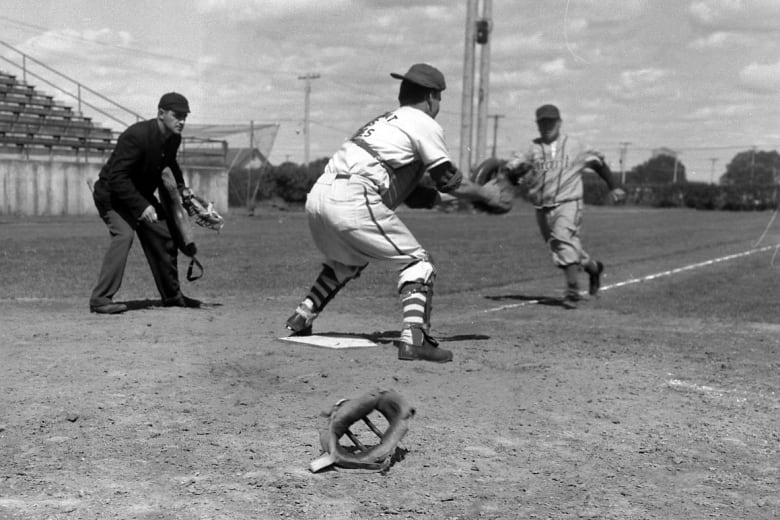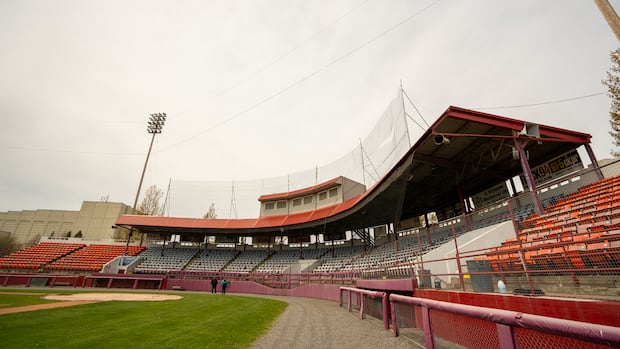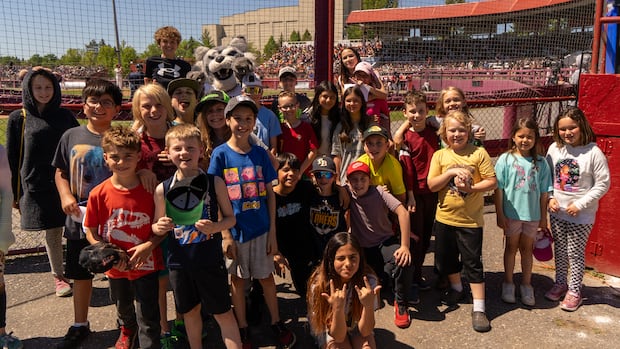Explore the rich history of Thunder Bay’s Port Arthur Stadium, host of the Women’s Baseball World Cup
Port Arthur Stadium in Thunder Bay, Ont., has been back in the international spotlight this month as the site of the 2024 Women’s Baseball World Cup finals, including today’s medal matches that involve Canada.
But hosting major events — baseball or otherwise — isn’t unfamiliar ground for the old building.
For years, the facility has hosted some of the biggest sporting moments in the northwestern Ontario city’s history.
“When it was built, it wasn’t just for baseball,” said Diane Imrie, executive director of the Northwestern Ontario Sports Hall of Fame. “There was football, there was soccer, there were track and field competitions held there.
“The Finnish community, too, actually held their festivals there as well,” she said. “The children’s festival was held there at one time as well, during the 1980s and early ’90s.”
Initial efforts to build a large stadium in the region stretch back to the 1930s before the cities of Port Arthur and Fort William combined to form Thunder Bay, Imrie said. But everything came to a halt with the outbreak of the Second World War. In 1948, work on the stadium in Port Arthur resumed.
“It almost didn’t happen, because there was a shortage of steel because of the war, but they got it shipped in,” Imrie said. “So for $200,000, they built the Port Arthur Stadium that opened in 1951.”
That occasion, of course, was marked with a baseball game.
“They actually brought in the New York Bengals All Star team,” Imrie said. “They played against some all-stars from here.”
As the story goes, some of the Bengals players were in an accident prior to the game, leaving the team three players short. So three local players switched sides for the night.
“We didn’t win,” Imrie said. “It was seven nothing [7-0] for the visitors, but really the fans didn’t care — 3,000 to 4,000 fans filled the stadium,” she said. “It was really unique also because it was the first game [in the city] played under the lights.”
The stadium became a full-time baseball facility when the Thunder Bay Whiskey Jacks became one of the six founding members of the Northern League, an independent baseball league, in 1993. Their arrival meant Port Arthur Stadium focused in on baseball.
“There was a lot of money spent on upgrading it specifically for that,” she said. “It was huge to get that professional baseball team here.”
Thunder Bay’s Port Arthur Stadium is back in the spotlight this week, hosting some of the world’s best baseball players for the Women’s Baseball World Cup finals.
The Whiskey Jacks were the second professional ball team to call the region home, Imrie said. In 1913, a team called the Canucks played in another independent baseball league.
That team existed prior to the construction of the stadium, of course. But Thunder Bay’s love for baseball, and sports in general, goes way back.
Today, the stadium remains a baseball facility; it’s the home field of the Thunder Bay Border Cats of the Northwoods League.
It is a classical ballpark for sure. It does show its age at times. The city has been pretty diligent trying to make repairs.– Bryan Graham, VP, part-owner of the Thunder Bay Border Cats
“It is a classical ballpark for sure,” said Bryan Graham, vice-president and part-owner of the Border Cats. “It does show its age at times. The city has been pretty diligent trying to make repairs.”
Since Graham and his partners bought the Border Cats in 2019, they’ve made repairs including new party areas and video screens to improve the fan experience at the ballpark.
Graham played baseball and football at the stadium. He recalls working as an announcer for junior football, and taking in concerts and soccer on the field.

“It’s funny, our souvenir store, the Cat Shack over on the west side of the stadium, on the first-base side, that used to be a dressing room for football,” he said. “We’d get dressed at high school and get all our pads on then, but come here and put our cleats on.
“Then, at halftime, cram in there trying to figure out what we’re going to do next to try to win the football game.”
Graham has seen plenty of changes at the stadium. The switch from bench seating to the current seats with the arrival of the Whiskey Jacks, the expansion of the press box on the roof — there was a time you’d need to climb what Graham described as a “submarine-style ladder” to get up there — to new fencing that replaced the repainted outdoor rink boards used previously.

He’d still like some other changes.
“Seating would be the number one thing,” Graham said. “I would love to see new seats that maybe are a little more colour friendly with the rest of the ballpark.”
The current seats are powder blue and orange, which don’t exactly mesh well with the Border Cats red that adorns much of the grandstand.
Graham isn’t sure where the powder blue seats came from. The orange ones, he said, were repurposed from the Greensboro Coliseum, so there were no opportunities to pick another colour.
“It is an interesting colour mix, that’s for sure,” Graham said. “When the renovations were happening at the Rogers Centre, we contacted the Blue Jays and actually at one point thought we were going to be able to get seats that they were taking out.
“Unfortunately, that didn’t happen,” Graham said. “They were not made available, and right now we still have the powder blue, the orange and a lot of red surrounding it.”
So what about the future? The park is nearly 75 years old, after all.
“That’s kind of the million-dollar question,” Graham said. “We’ve had some talks with the city about the lifespan.
“It seems to be holding up pretty well,” he said. “The grandstand every now and then needs a little bit of patchwork, for sure. Down the road, there’s going to have to be some serious conversations.”
The Thunder Bay Border Cats entertained more than 2,300 elementary school students earlier this week at the first School Day Game of the season. The CBC’s Sarah Law is new to the sport. So, she went to Port Arthur Stadium to learn all about it from the pros.
Graham said one thing the Cats’ ownership would like to see is more non-baseball events, like concerts.
But Andrew Foulds, a Thunder Bay baseball fan and city councillor, said that’s unlikely.
“The City of Thunder Bay is finally getting its act together and treating recreational facilities in their asset management plan,” he said. “Whether it was a park or recreation facility, we kind of just left them wear away.
“We have, as the municipality, made a tremendous amount of investment into the field there, and baseball fields aren’t just sort of here’s some dirt, here’s some grass and here’s some sand and here’s a ball field. These things are now engineered, and there’s a science behind them.”
There’s concern, Foulds said, that another type of event may damage the field.
“I think we need to start thinking a little bit more about what that maintenance and rejuvenation of the spectators’ experience is going to be,” he said. “I also think if we want to attract top players to the Border Cats, their experience also needs to be positive.
“I want some of the top players to say, ‘Hey, I played in Thunder Bay. It was a world-class field, and world-class coaching and world-class facilities. I want to go back.'”




